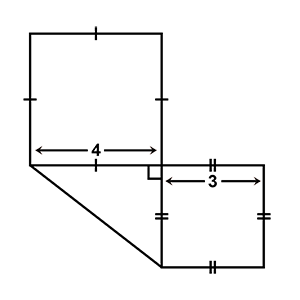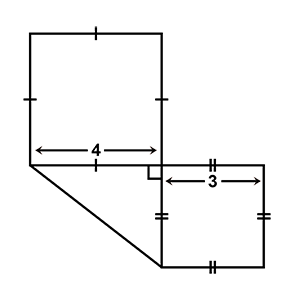Answer
423k+ views
Hint: In order to solve this problem, we must remember the formulae of area of the square and area of the right angle triangle along with the proper understanding of the figure that is being provided in the question.
Complete step-by-step answer:

In the question it is given two square ABCD and DEFG of side 4cm and 3cm respectively and one triangle CDG. From the figure it is clearly seen that triangle has two sides common one with square of side 4 cm and other one with the square of side 3 cm, hence two side CD and DG of triangle CDG are known, only one side CG is left to find which can be find by Pythagoras theorem.
We know that
Area of a square is defined as the number of square units needed to completely fill a square. Area of a square can be given by the formulae:
Area of a Square = Side × Side
Therefore, the area of square = ${Side^2}$ sq. units
Area of square ABCD with side 4 units = ${4^2}$= 16 sq. units
Similarly
Area of square DEFG with side 3 units = ${3^2}$= 9 sq. units
A right-angled triangle is the one which has 3 sides, base(CD), hypotenuse(DG) and height(CG) with the angle between base and height being 90°. So in the triangle of given figure base =4 cm and height = 3 cm.
The area of a triangle can be calculated by formulae:
Area of the triangle CDG = $\dfrac{{{\text{Base}} \times {\text{Height}}}}{2}$
On putting the values of base and height
Area of the triangle = $\dfrac{{4 \times 3}}{2}$= 6 sq. units
∴ Area of the given closed figure = Area of the square ABCD + Area of the square DEFG + Area of the triangle CDG
∴ Area of the given closed figure =16+9+6=31 sq. units
Hence Option A is correct.
Note: Whenever we face such types of problems the key concept we have to remember is that always remember the formulas of area of the square and area of the right angle triangle which are stated above, then using these formulas calculate the areas of all polygons and at last add all the areas of different parts, which will be our required answer.
Complete step-by-step answer:

In the question it is given two square ABCD and DEFG of side 4cm and 3cm respectively and one triangle CDG. From the figure it is clearly seen that triangle has two sides common one with square of side 4 cm and other one with the square of side 3 cm, hence two side CD and DG of triangle CDG are known, only one side CG is left to find which can be find by Pythagoras theorem.
We know that
Area of a square is defined as the number of square units needed to completely fill a square. Area of a square can be given by the formulae:
Area of a Square = Side × Side
Therefore, the area of square = ${Side^2}$ sq. units
Area of square ABCD with side 4 units = ${4^2}$= 16 sq. units
Similarly
Area of square DEFG with side 3 units = ${3^2}$= 9 sq. units
A right-angled triangle is the one which has 3 sides, base(CD), hypotenuse(DG) and height(CG) with the angle between base and height being 90°. So in the triangle of given figure base =4 cm and height = 3 cm.
The area of a triangle can be calculated by formulae:
Area of the triangle CDG = $\dfrac{{{\text{Base}} \times {\text{Height}}}}{2}$
On putting the values of base and height
Area of the triangle = $\dfrac{{4 \times 3}}{2}$= 6 sq. units
∴ Area of the given closed figure = Area of the square ABCD + Area of the square DEFG + Area of the triangle CDG
∴ Area of the given closed figure =16+9+6=31 sq. units
Hence Option A is correct.
Note: Whenever we face such types of problems the key concept we have to remember is that always remember the formulas of area of the square and area of the right angle triangle which are stated above, then using these formulas calculate the areas of all polygons and at last add all the areas of different parts, which will be our required answer.
Recently Updated Pages
The branch of science which deals with nature and natural class 10 physics CBSE

The Equation xxx + 2 is Satisfied when x is Equal to Class 10 Maths

Define absolute refractive index of a medium

Find out what do the algal bloom and redtides sign class 10 biology CBSE

Prove that the function fleft x right xn is continuous class 12 maths CBSE

Find the values of other five trigonometric functions class 10 maths CBSE

Trending doubts
Difference between Prokaryotic cell and Eukaryotic class 11 biology CBSE

Fill the blanks with the suitable prepositions 1 The class 9 english CBSE

Write an application to the principal requesting five class 10 english CBSE

Difference Between Plant Cell and Animal Cell

a Tabulate the differences in the characteristics of class 12 chemistry CBSE

Change the following sentences into negative and interrogative class 10 english CBSE

What organs are located on the left side of your body class 11 biology CBSE

Discuss what these phrases mean to you A a yellow wood class 9 english CBSE

List some examples of Rabi and Kharif crops class 8 biology CBSE




